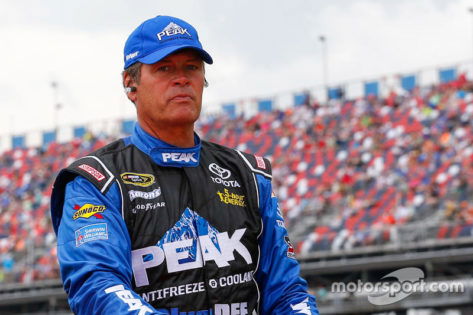Michael Waltrip’s NASCAR story has always had a little bit of everything — heartbreak, underdog grit, and unforgettable triumphs. He spent years chasing his first Cup Series win, enduring more than 460 starts before finally breaking through in the most dramatic way possible at the 2001 Daytona 500. But, that doesn’t stop people from assuming that he disapproves the next-gen cars.
“I get so tired of hearing, ‘Racing ain’t like what it used to be.’ I get that a lot because I’m old, and they think I would agree that it was better back in the day. Well, it wasn’t. That’s not true.” Classic blunt and truthful Waltrip! Beyond the driver’s seat, Waltrip carved out a second act as a team owner, TV analyst, and garage favorite.
His career spanned eras where the sport changed drastically, but his old-school spirit never wavered. And now, as the modern-day NASCAR world speeds ahead, Waltrip took a moment to reflect on the era that built him, one where garage-built Busch cars and weekend hustles made champions.
Michael Waltrip’s garage-built NASCAR dream
In 1995, Michael Waltrip took a leap of faith, building his own Busch Series car in a modest shop behind his house. “I had a shop behind my house,” he recalled, “and you have to know the generation or the era that I grew up in.” This era saw many Cup drivers, like Dale Earnhardt and Darrell Waltrip, running their own Busch teams. Inspired by Earnhardt’s journey from a small garage to Dale Earnhardt Incorporated, Waltrip followed suit.
Waltrip’s early team, Michael Waltrip Racing (MWR), was a hands-on operation. “You go to one guy and get a chassis. You go to another guy, he’ll put a body on it for you,” he explained. “Then, you get somebody, and they supply you, or you buy an engine or lease an engine.” This patchwork approach was typical of the time, reflecting the resourcefulness required to compete. Waltrip’s dedication paid off, as he began winning races as both driver and owner.
The team expanded, giving opportunities to drivers like David Reutimann. “We were able to take that and win races,” Waltrip said. Reutimann won two NASCAR Cup Series races for MWR—the 2009 Coca-Cola 600 and the 2010 LifeLock.com 400. He also delivered Michael Waltrip’s first NASCAR Nationwide (now Xfinity) Series win as an owner at Memphis in 2007. Other drivers who got opportunities with Michael Waltrip include Patty Moise, Shawna Robinson, and Kerry Earnhardt. This collaborative environment fostered talent and demonstrated Waltrip’s commitment to nurturing the next generation of racers.
By 2007, MWR had grown into a full-time Sprint Cup team. It became the first to field three Toyota Camrys in the series. The team achieved notable success, including a Daytona 500 victory with Waltrip himself and wins with drivers like Clint Bowyer and Martin Truex Jr. MWR’s rise from a backyard garage to a competitive Cup team exemplified Waltrip’s vision and perseverance. But this streak of success did not continue long enough.
Despite its eventual closure in 2015, MWR’s legacy endures. Waltrip’s journey from building cars behind his house to leading a top-tier NASCAR team highlights the determination and passion that define the sport. He loves what the next-gen car is doing to the sport. “It’s more competitive now than ever. We go to better, more fun venues than ever. We’re doing new things. I’m just really happy with where we are,” Waltrip said, reflecting on the significant contribution.
His story serves as an inspiration, reminding us that with grit and vision, even the most modest beginnings can lead to greatness. Notably, Michael Waltrip belonged to an era where drivers were more responsible for their car’s performance than crew members.
The lost art of drivers building their own cars in NASCAR
Once upon a time in NASCAR, drivers didn’t just race. Instead, they built, tuned, and sometimes even designed their own cars. Legends like Dale Earnhardt, Herb Thomas, and Adam Petty were as comfortable with a wrench as they were behind the wheel. These greats forged a direct connection between man and machine that’s now largely lost to history. This hands-on tradition helped define the sport’s early decades.
As NASCAR evolved, the rise of specialized chassis builders like Holman-Moody and Banjo Matthews in the late 1960s and 1970s marked a turning point. Teams began outsourcing more of the technical work, and the days of drivers fabricating their own cars faded. By the time multi-car super teams and big-money sponsors took over, the owner-driver was a rare breed. Tony Stewart’s 2011 championship stands out as a modern exception.
Today’s NASCAR machines are the product of a highly collaborative process involving manufacturers, teams, and specialized vendors. Drivers focus almost exclusively on driving, while engineers and fabricators handle the technical side. As a result, the old-school skill set of building your own car has become a forgotten art, romanticized by veterans and fans alike.
NASCAR Hall of Fame Junior Johnson once reflected on this shift, saying, “Back then, you had to know every nut and bolt on your car. Now, you just drive what they give you.” Tony Stewart, one of the last successful owner-drivers, echoed this sentiment: “It’s a different world now. I miss the days when you could build something in your own shop and take it to the track to beat the big teams.”
While today’s drivers are among the world’s best athletes, the era of building your own car from scratch is gone. The sport’s relentless push for parity and safety has made the process more sophisticated. But it’s also left some longing for the days when a driver’s mechanical ingenuity could make all the difference.
The post Michael Waltrip Looks Back at NASCAR’s Forgotten Era as He Joined the Elites From His Garage appeared first on EssentiallySports.



